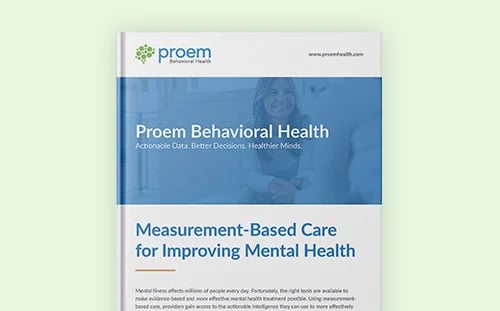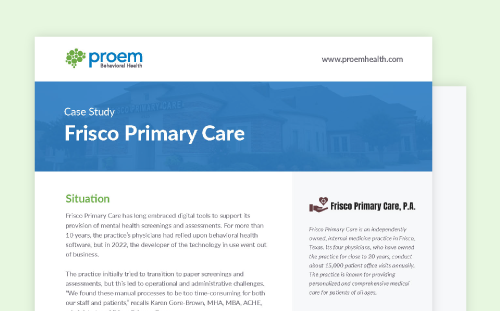Dual diagnosis treatment is among the most demanding challenges facing substance use disorder (SUD) clinics. Data suggests that more than 15% of individuals with SUD also have a serious mental illness (SMI) and nearly 30% of individuals with SMI also have SUD, yet only 10% of people with both conditions receive comprehensive care.

Each person presenting for substance use treatment is an opportunity to close that gap. By adapting their clinical workflow to incorporate dual diagnosis treatment, SUD clinics can improve diagnosis and treatment accuracy and strengthen outcomes, one patient at a time.
1. Thoroughly Assess for Co-Occurring Disorders
Approximately 18 million adults in the United States struggle with both mental health and addiction. These individuals often present for treatment with limited or no awareness of their diagnostic picture.
Correctly identifying co-occurring drug, alcohol and mental health interactions is difficult, even for trained clinicians. These conditions have a bidirectional relationship that involves common risk factors, complex causal pathways and overlapping symptoms.
One patient’s anxiety and paranoia may stem from the misused substance or an underlying mental illness. Another may experience neurological changes arising from ongoing substance misuse, ultimately leading to a mental illness that had been developing under the surface.
To avoid misdiagnosis and provide complete care, SUD clinics must universally screen for mental health disorders and SUD at intake. The key is to integrate clinically validated screening tools that identify warning signs and recommend in-depth assessments as necessary. This integration reduces the potential for human error and flags more candidates for dual diagnosis treatment.
2. Implement an Integrated Treatment Model
Co-occurring disorders inevitably impact one another and affect an individual’s treatment outcome. However, due to the siloed nature of behavioral care in the United States, most patients see separate providers for substance use and mental health needs. According to the Substance Abuse and Mental Health Services Administration (SAMHSA), this separation contributes to many patients not receiving the necessary, comprehensive care.
SAMHSA believes the best solution is an integrated care model in which providers collaborate on a dual diagnosis treatment plan. Clinicians must work together to understand a patient’s co-occurring disorders and develop a complete treatment strategy.
According to SAMHSA’s Evidence-Based Practices Kit, “Integrated treatment plans … treat both serious mental illnesses and substance use disorders so that consumers do not get lost, excluded, or confused going back and forth between different mental health and substance abuse programs. Consumers receive one consistent, integrated message about substance use and mental health treatment.”
This approach prevents the most serious effects of fragmented treatment, in which single-diagnosis treatment worsens a related condition. Instead, patients learn about their co-occurring disorders and receive appropriate treatment plans.
3. Develop Individualized Treatment Plans
Every patient responds to treatment differently, even if they are diagnosed with the same conditions. Successful dual diagnosis treatment requires clinicians to understand the patient as an individual, adapting care according to personalized needs and preferences.
Such personalization is an ongoing process, requiring access to updated patient data from all providers. Clinicians must be able to view patient progress updates and conveniently communicate with all colleagues on the patient’s team, including outside providers.
Digital solutions make this possible. Integrated assessment tools allow clinicians to track a patient’s progress and view data on each diagnosis. With this information, the team can adapt the treatment plan for the individual instead of reacting to changes in a single dimension.
4. Acknowledge the Impact of Trauma on Drug Use, Alcohol and Mental Health
Given that traumatic experiences increase the risk of mental health and substance use disorders, it’s unsurprising that trauma histories are common among those in recovery. Trauma affects a patient’s clinical presentation and responses to therapeutic interventions, and each patient’s response will be different.
SAMHSA urges all clinics to implement trauma-informed services, beginning with the understanding that trauma influences an individual’s openness to services. Trauma-informed care creates a psychologically safe environment that accommodates a person’s unique experiences, with services adjusted to help ensure they are as supportive as possible. Trauma screening and evaluation is an essential step in this process, as is effective recordkeeping throughout recovery.
5. Ensure a Seamless Continuum of Care
Dual diagnosis treatment is rarely a linear experience. Progress in one domain often co-exists with a setback in another, and life experiences may aid or inhibit the entire process.
To provide effective care, clinicians must continuously monitor overall progress. Ongoing reassessment of both conditions is vital, and all providers must participate. This level of care coordination may be a significant challenge for some providers, mainly when treatment requires external collaboration.
A study in Psychiatric Services revealed several ongoing barriers, from communication regulations to procedural inefficiencies. For example, initiating and maintaining contact with providers at other agencies, one participant explained, generally devolves into frustrating games of “phone tag.” Providers reported that confidentiality concerns and substance abuse treatment agency policies addressing disclosure of client information also stymie efforts to coordinate care.
These challenges continue as the patient moves through treatment. In the ideal scenario, clinic teams connect a “graduating” patient with aftercare and sources for long-term support so that minor challenges don’t result in complete relapse.
6. Incorporate Ongoing Assessment of Co-Occurring Disorders
Faced with an unpredictable clinical picture, standardized assessment tools help clinical teams stay on track. These tools enable evaluation across multiple domains, allowing for more effective progress tracking.
Patients in dual diagnosis treatment may experience shifts in one diagnosis or another, and a lack of data easily muddles the situation. Standardized assessments evaluate the patient’s status according to all diagnostic criteria, allowing clinicians to see the details and holistic situation in turn.
By routinely assessing all presenting diagnoses using clinically validated instruments, clinicians reduce the risk of missing a key indicator.
 Follow Proem Behavioral Health on LinkedIn to help you stay current with the latest behavioral and mental health news.
Follow Proem Behavioral Health on LinkedIn to help you stay current with the latest behavioral and mental health news.
Improve Dual Diagnosis Care with Proem
Standardized tools allow clinicians to overcome barriers and keep their focus on the patient. Proem’s behavioral health solution uses evidence-based clinical measurements and a specialized workflow engine to help providers evaluate each patient quickly, accurately and reliably. Tools are easy to administer in-office or remotely, depending on the clinic’s workflow, and evaluations for multiple diagnoses are available.
With Proem, clinicians receive the recommendations they need to provide evidence-based care while patients enjoy a smoother and easier evaluation process. To find out how Proem solutions can help with better SUD outcomes, book a meeting.





.png)









